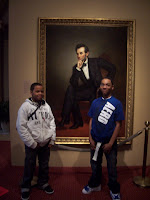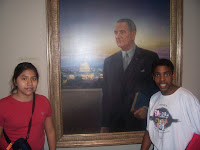We started this month's scavenger hunt with a few questions on prominent African Americans. We visited the Picturing the Promise exhibit in the National Museum of American History. As soon as teams answered the first research questions, they were given the actual scavenger hunt and they rushed off to see who would come back a winner. See the research handouts and scavenger hunt that are posted at the end of this entry.





Clue #1 Defending Freedom
Head to the Emancipation Proclamation section on Floor 2 of the American History Museum.
Even after President Lincoln signed it, he was Defending Emancipation by stating it was a military necessity to do what?
___________ black ___________
Without them, Lincoln would have lost the Civil War!
What person below would have helped Lincoln make his argument of why the US needed to emancipate the slaves?
a) Duke Ellington
b) Jackie Robinson
c) P.B.S. Pinchback
Get a photo of both of you in front of a copy of the Emancipation Proclamation signing your answer.


Clue #2 Music Across the Ages
Head to Thanks for the Memories section of the American History Museum and find the art form that just won’t stop! That’s right African Americans have created two unique musical styles that the world is crazy about.
According to Fab Five Freddy, What is the embodiment of a spirit of creative rebellion, freedom? _________ ____________
At the beginning of the 20th century, Jazz was considered rebellious and also a symbol of freedom from traditional piano styles.
Which person below has played one of these uniquely American music styles?
a) Duke Ellington
b) Madam C.J. Walker
c) Jackie Robinson
Get a photo of both of you signing your answer in front of the jacket in this exhibit.


Clue #3 A New Bank
Hurry, quick! It’s an emergency! You must find a “Nebula Mac” on the third floor of the American History Museum! Wait, you don’t know this vehicle?
OK, unscramble “Nebula Mac” to figure out what type of vehicle you are looking for.
Unscramble here:
Next, once you find this vehicle from 1898, figure out which person connects to it in your research.
Shoot a video where one of you acts like you are going to an emergency while explaining how this person from your research connects to this vehicle.
Clue#4 Can I Order Please?
Could you grab a sandwich at this counter in 1960? Maybe not. But 4 college students in Greensboro, North Carolina took lessons from the non-violent example of the Montgomery Bus Boycott to stop segregation at this Woolworth lunch counter.
Who was their inspiration?
a) Carter G. Woodson
b) Charles Drew
c) Dr. Martin Luther King Jr.
Get a picture of both of you signing this answer while standing in front of this artifact on the 2nd floor of the American History Museum.
ATTENTION: There is a play here at 11 & 12 so it will be hard to take this photo when the crowd is there.


50 BONUS POINTS
Shoot a short video of the play in clue #4 and then act like a reporter explaining what
has just happened!
Clue #5 Business Travel
America is on the Move and you better find out how this relates to Black history. Stay in the American History Museum and search out a Pullman Porter to help you with this clue.
Being a Pullman Porter meant you worked on a __________.
In the 1920s, Pullman Porters were biggest employers of whom? ___________________________
Since Pullman Porters were so connected, they also helped change things for African Americans in this country. Name one Pullman Porter and what he did to improve life for African Americans: _________________________& What did he do? ____________________________________________
All the traveling, success and respect of the Pullman Porter makes us think of another important figure that traveled across this great nation to become very wealthy with her own business. Who was that?
a) Lucy Diggs Slowe
b) Jackie Robinson
c) Madame C. J. Walker
Get a photo of both of you signing the correct answer standing next to a Pullman Porter.

Clue #6 Role of the Military
It sure has been a Changing Nation for African Americans in the American History Museum and the many wars we fought also helped to change our nation. But “What has U.S. Military Service Meant to Black Soldiers?” is a good question.
(Find the Answer!)
Veterans of the civil war would say that freedom and citizenship were not given but were __ __ __ __ __ __ and that becoming a soldier helped them to “speed the transition from _____________ to _____________” because after the war many soldiers became the ________________ of ____________ in the south and in the nation.
Who from your research would most likely agree with these statements?
a) Charles Hamilton Houston
b) Duke Ellington
c) James E. Walker
Get a photo of both of you signing this answer in front of the “Colored Soldiers” poster.


Clue #7 Achieving Equality
Brown v. Board of Education was the court case that made it illegal for schools to be segregated. Many lawyers worked many hours to make this happen. But people were not pleased or willing to let their schools become integrated. Find the artifact near the information desk on the first floor of the American History Museum that connects to this clue.
Who from your research helped to win this legal battle?
a) Carter G. Woodson
b) Charles Hamilton Houston
c) Major James E. Walker
Get a photo of both of you signing the answer in front of this artifact.
No Team Solved Clue #7
Clue # 8 A Head Above the Rest
One factor in understanding African American Life & History is to study the ancient past. Head to Constitution Ave. and walk to the Natural History Museum. That big face that you see could be evidence that Africans sailed to Mexico WAY before Columbus sailed the ocean blue.
What culture does this head belong to?
Not many people know this fact but if you study Black History you’ll find how they could be from Africa.
Who from your research would know this?
a) Lucy Diggs Slowe
b) Charles Drew
c) Carter G. Woodson
Get a photo of the both of you signing this answer next to this head.


Clue # 9 Veritas Et Utilitas
Head to the African Voices section of the Natural History Museum. The window is where you will need to go! Check out how the Civil War created an Institution!
Why did African Americans come to DC?
What did the Freedman’s Bureau build and sell?
What was made with the profits?
What year did this happen?
Now look at your research:
How many years later would the first Dean of Women be chosen?
Who was this? V) Madam C.J. Walker
W) Lucy Diggs Slowe
X) P.B.S. Pinchback
Get a photo of both of you signing this answer in front of the photo of this institution.


Clue # 10 Breaking Barriers
Head to the Smithsonian Castle and find Althea Gibbs’ Trophy. Trophy for what? She has something in common with one of the people on your research page.
Shoot a short video in which one of you explains why Althea Gibbs won a trophy and who she connects to. Explain what they have in common.
Clue #11 Road to Freedom
Head to the International Gallery in the basement of the Ripley Center. You must enter the Road to Freedom exhibit but you cannot take photos or video inside.
Research:
When was the Civil Rights Act passed?
What did it prohibit?
What did it not address?
Why were protesters marching from Selma to Montgomery Alabama?
What did President Johnson sign 5 months later?
Choose one photo in this section of the exhibit that shows the march from Selma. Study it and imagine you are in that photograph.
Now go outside to the main entrance and stand in front of the sign of the exhibit and shoot a video in which you explain why you are marching from Selma and what you hope to accomplish. Act like you are really there.
50 Point Bonus! Can you find on the main entrance level to the African Art Museum someone who represents a monumental first in Black History? Snap a photo of both of you in front of it!






























